[Important] Nagomi Visit will have a new operating organization starting September 1.
Your reservations and information remain unchanged.
Learn more
Blog
2015-01-31
Alternative title: Why I stopped telling people Japan was not mysterious or weird
My reasons for caring so much about Nagomi Visit are very personal.
What I want to accomplish through Nagomi Visit is to have as many people
- experience and get to know the real Japan
- realize that underneath the more obvious cultural differences, there are more similarities that bring us together as humans
Why would I want to work so hard to make this happen?
The simple answer? My experiences growing up Japanese-American in Texas.
I grew up in an environment during the 80s and 90s in the States where Japan was thought of as a mysterious land from the Far East described by books like Memoirs of a Geisha. On the other hand, when I met people who loved Japan they were in love with a magical place only described by the fansubbed anime they were watching.
Now a decade or so later with Japanese words like “umami” being used in mainstream foodie shows, times have changed since then. But it is hard to believe that things are completely different and all for the better when I continue to see articles on supposedly journalistically legitimate newspapers exaggerating how zany Japan is.
Not many people saw the country for what it really was, and this still continues to this day.
To fight these extreme stereotypes of Japan my solution back in the day was to start a website called Real Japan. It was a little bit famous among Japanophiles in the late 90s so there is a slight chance that you may know about it. Well, most likely not. The name of the site kind of gives it away, but basically the website was trying to show the “real” Japan not depicted in guidebooks. Or, at least what I thought was the “real” Japan at the time.
The content of the website was filled with pictures I scanned from various summer family trips to Japan. About daily life like school, music, fashion...I covered whatever I could.
I sometimes look back at some of the content that still can be seen on Internet Archive and I must admit some of what I wrote does make me cringe a bit. Like I would not exactly consider coverage about cool Japanese vending machines an article about the true side of Japan. However, even these articles which were on the superficial side were more “real” than the information that was out there at the time.
Fast forward to the 2010s, I am no longer the Japanese-American teen in the States armed with a website but in my thirties having lived in Japan for 10 years and now the Chief Operating Officer of Nagomi Visit.
There is much more information out there about Japan so I feel like my job is not to write about the “real Japan” but help people get to the source, which is the actual people who live in Japan and let them do the sharing of what is "real."
So what all started from frustration of feeling like one side of my Japanese-American bicultural self was being misunderstood, is now my life’s work.
I know the actual Nagomi Visit itself only lasts a few hours but I want participants to see it as an opportunity for opening doors to communication between people who might otherwise not have a chance to meet and that it will just be the beginning of a great friendship where everyone will see each other as whole people.
2015-01-11
Paul from the UK who visited 7 hosts in various parts of the country summarizes the experience very well. "Everyone is different. Every single visit has been different in every way. So if you want to experience more you gotta do more I think."
"I think each one has their own moments. It’s difficult. I can’t say one was definitely better than any other. For instance my host in Kyoto quickly made me feel at ease. I’m not sure why that was the case. Maybe it was because we started joking around fairly quickly. I knew she was a relaxed so I knew there was less chance of offending her. Same when her friend turned up. They were relaxed around me. "
"In Hiroshima my host invited her neighbor. She was an art teacher. She was just a really interesting person. We started chatting and she gave me her book of her work. I thought she was a fascinating person so that was interesting."
"The two daughters and the wife in Takamatsu, again, they were great. As soon as we got to their house we were chatting and laughing which made me feel at ease as well. They did origami with me. We made some paper cranes so that was cool as well. One of the girls plays piano and she learned the UK national anthem, and they eventually got me to sing it. That was really funny. That was quite a funny experience. Again that was totally different from anything else I’ve done. I can’t believe she learned the whole national anthem just like that as well. That was cool."
"So like anything else, there is no one that is more outstanding than the other. They have all been absolutely brilliant."
"The biggest surprise for me was no two meals were the same. Ok miso soup was a popular thing but even then that was different in every place. They would put different things in it."
We asked a few more guests about their experiences meeting multiple hosts.
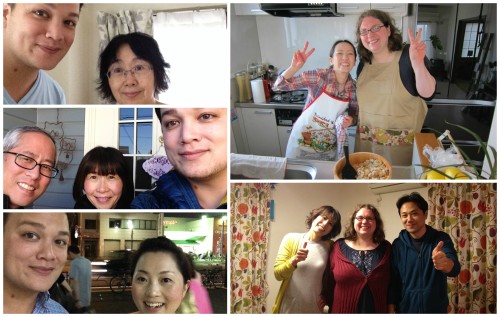
First we asked a guest from the Netherlands traveling to Japan for the first time. When we asked why he decided to book more than one Nagomi Visit he gave us a great comprehensive answer.
I still looking back with so much pleasure at my two Nagomi Visits. It were the highlights of my trip through Japan. If I have the possibility to visit Japan again, I would start with booking Nagomi Visits.
Why did you decide to book more than one Nagomi Visits?
I wanted to meet Japanese people at their own home. I heard it should not be easy to visit Japanese people at their own home. So I was very pleased to find Nagomi Visit. I read that I could meet them and have diner/lunch with them at their home. That was exactly what I was looking for. I read on your website that is was possible in different cities. I looked at my travel schedule to find cities where you offered possibilities. I decided to ask for two cities to start with but I would like to ask for more.
Were you glad you visited more than one host?
Yes, very much. It was a pity that I did not booked more visits. I felt so comfortable when I was at both their homes. I was sorry to leave them again.
What did you learn from visiting more than one host?
It were two very, very nice hosts. They where real different from each other. That makes my experiences so much completer, richer. Three or more would have made it even more complete for me.
Second was a guest from Hong Kong traveling to Japan for the first time. He mentioned that he saw Nagomi Visit as a great opportunity to meet people during his travels, especially since he was traveling solo.
Were you glad you visited more than one host?
Sure!!..My 2 visits were rather different in family background. 1 of them is in the Tokyo city center, while the other one is at an non-tourist area of Tokyo,with 3 kids
What did you learn from visiting more than one host?
I think that the more you visit, the more you know about Japan (or Tokyo), and I see different part of this city, the country.
I met host just living near Shinjuku, I see the life in the very center of Tokyo, the food, the house, the life style of modern Japanese people.
The other host shall be in a suburb of Tokyo ( I think ). But the host with her family gave me another experience, a Japanese home style, an very tranquil place, with good sashimi~ My host couple really made good Japanese dishes! By the way, they are both interested in my culture as well. They were very eager to know more about my living.
I met people in different ages, from different background, living in different part of the city. I communicated with them and know how the life is in Japan, in different aspects.
I know more about how Japanese people think about their country, learn different culture ( I know how to make the roll with seaweed, sashimi, rice and a special leaf) and get to know a bit about life and living in Tokyo. Moreover, I discover the attractiveness of small town in Japan, which is really out of a tourist reach.
It is quite special when comparing the 2 hosts. Since I deliberately choose my 2nd host with kids.
So my visits made me met young people in similar age, in youth, met couples with kids.
Third, we asked a guest from Germany who was also visiting Japan for the first time but since she was also interested in cooking, she decided to participate in a Cooking Visit in addition to her two Nagomi Visits in Tokyo and Kyoto.
Were you glad you visited more than one host?
Absolutely. All three experiences were different - the first dinner was where we were joined by the neighbor, and it was really lively and warm atmosphere. The cooking visit was exciting and very educational. During the third visit it was just the two of us and thus different from the first dinner, but also a very friendly atmosphere.
What did you learn from visiting more than one host?
Apart from that it was also interesting to meet people from different parts of the country with different living arrangements and obviously also different life experiences...Basically the good thing about doing more than one Nagomi visit is the chance to meet even more new people and make maybe more new friends. And also try different foods, but I admit while the food was always delicious, it was secondary to meeting my hosts.
We also asked a guest from the US about his multiple Nagomi experiences, especially since he has been to Japan before many times.
Were you glad you visited more than one host?
Absolutely. I've raved about this service to everyone I know!
What did you learn from visiting more than one host?
I was able to visit three separate homes in three very different areas... places that I would otherwise have no reason to visit. I was able to meet three very different people.
Mari I., Shizu S., and Mari T. were all very, very nice. The meals and time that I was able to share with them are among the most enjoyable experiences that I have had in Japan (I have visited Japan 6 separate times).
These are just a few out of many Nagomi Visitors who chose to visit more than one host. We will continue to share more!
2014-12-21
The short and sweet answer is that it is all up to you. This is what we hope makes participating in a Nagomi Visit special.
We've had hosts and guest tell us lovely reunion stories.
Here is a host who reunited with her guests in Singapore and Peru.


Many others decide to make plans right after while both parties are still in Japan such as going out to eat at one of the host’s favorite restaurants, or participating in a local matsuri festival the next day. The sky has been the limit for what our participants have done post-Nagomi Visit.
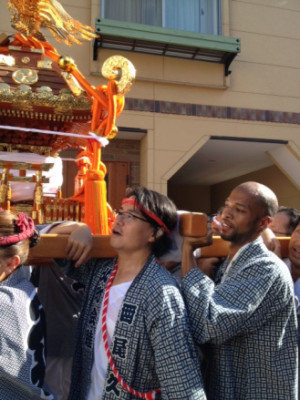
Others in the meantime keep in touch by sending postcards, care packages, and photos.
Here is a photo of a guest who shared the origami techniques they learned from their host and used to decorate their Christmas tree.


If you have any post-Nagomi photos we'd love to see them and share!
2014-12-14
Still trying to figure out whether or not Nagomi Visit is for you? Let the blogs speak for themselves!
Here is the start of a roundup of various posts we found around the internet in various languages talking about their Nagomi Visit experiences.
Though we don’t edit any of the testimonials or reviews shared on our website, thought these blog posts will be more convincing since it is visually obvious we have no control over these posts. So here it goes, starting with a few English blog posts.
First, the English Nagomi Visit Reviews
We’ve actually had travel writers, journalists of all sorts write on their personal blogs of their experiences and this is one of them. Here is another example of a photographer sharing her experience with her breathtaking pictures.
Reviews by expats and students living in Japan
We have had expats and students studying abroad in Japan who decided to participate in Nagomi Visits simply because it’s just a good way to start immersing yourself into the culture.
"Nagomi Visit is a must-do if you’re living in Japan," she says. Here is a comprehensive post from a lovely participant who actually lived in Japan at the time.
Thoughts on Nagomi Visits in Osaka and beyond
Here are just a few written by guests who participated in our various other locations besides Tokyo. This first one is from a Nagomi experience in Osaka.
"Another highlight was our Nagomi visit organised by my sister inlaw. It was such a fun occasion, getting an insight into Japanese people’s home and cooking. A snippet of their lives, really. If you’re ever going to Japan, please do make sure you get to do it too! For the whole 3 hours we were there, I smiled the whole entire time. The experience authenticated my trip, if that makes sense?”
Here is another from some great people who visited hosts in Nagoya.
“I had a special treat for dinner tonight as I was hosted by the Saitoh's at their home. They are part of a host programme, Nagomi Visit, and would host dinner (and share their love for Nagoya and Japan) to tourists in Nagoya. They are an absolutely lovely and friendly couple. If you're looking for a friend away from home, look no further!”
“Dinner was a delicious meal with tempura, rice steamed with other ingredients, miso soup, salad and konyaku, all expertly prepared by Sadame! I had so much fun chatting with them, and time just flew by. Meeting them felt like catching up with old friends I haven't met in a while. Jokes, conversation and laughter filled our time together, and I think I will have sore cheeks tomorrow from laughing too much.”
There are many, many others just like the following but we will stop around here as I think you get the point by now!
"For dinner we went to a Nagomi visit where a local family lets you visit their houses and cooks you homestyle Japanese food for dinner. Our family cooked us Oden which is a type of vegetable and fish stew. I highly recommend doing this if you come to Japan."
What it's like to Cooking Visit
Lastly, here is another review of our Cooking Visit program. The great thing about this write up is that it represents a lot of the comments we receive from people these days. Since we have been running this program a couple of years, we are getting a lot of people participating again every time they come to Japan. Other’s like the following couple here are hearing about Nagomi Visit from the grapevine which is very exciting.
"Our friends Rob and Aly recommended this organization for an in-home cooking lesson, and we’re really happy we took their advice. Not only do you get to learn some new skills and ingredients and enjoy a delicious meal, you also get a structured conversation with a local who can guide you during your stay."
Japanese Reviews (some with English translations)
This is a great post by one of our hosts that is both in Japanese and English so you can get a sense of what our hosts are like.
All these four blog are all in Japanese but is a wonderful example of how the Nagomi Visit host network is growing all across Japan and how we are now able to share local family traditions from various regions of Japan.
This last one isn't written by a participant but is by a hostel employ who wrote about Nagomi Visit on their blog after hearing about our program from a guest from Australia that participated in a Nagomi Visit.
Reviews in various languages (including video)
Here is a video by a past guest from Russia of her Nagomi Visit. The Nagomi part starts around 8 minutes 17 seconds. This is the blog post that goes with the video. Here we have a very comprehensive review in Dutch with pictures, a Japan travel guide in Dutch which includes details about a Nagomi Visit...the list seriously can go on and on if we include everything so here is just a quick roundup!
If you have any blog posts to share with us or anything, we look forward to hearing from you!
2014-12-08
There is more to a Japanese Christmas than what you may have read. It is not always just about eating Kentucky Fried Chicken or spongy strawberry shortcake. Not that that's bad since the cakes are sure soft, moist and deeeelicious! We just hope you will be able to discover how our locals celebrate differently through Nagomi Visit.
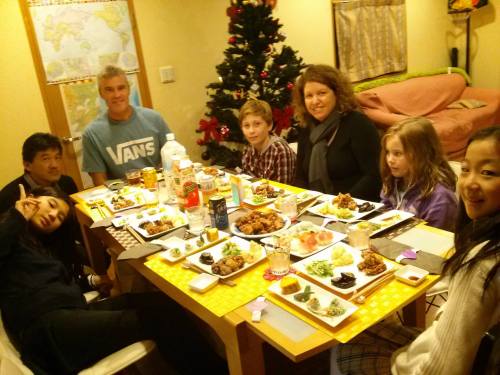
Here are just a few examples of how our hosts have gotten creative.
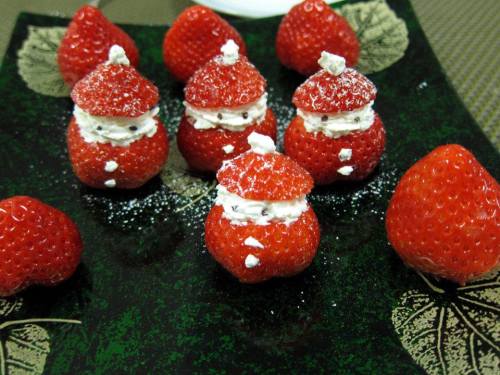
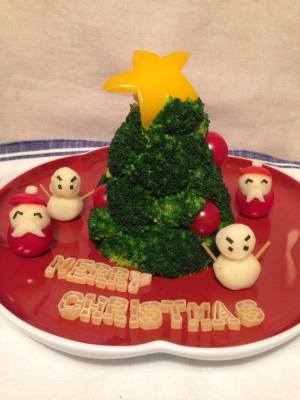
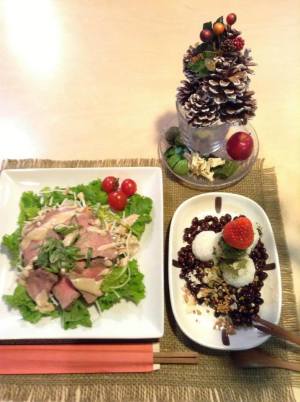
Some Christmas themed santa and snowman sushi art anyone?
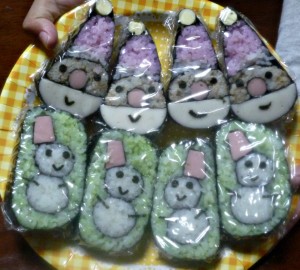
Or some Japanese-style roasted chicken marinated in soy sauce?
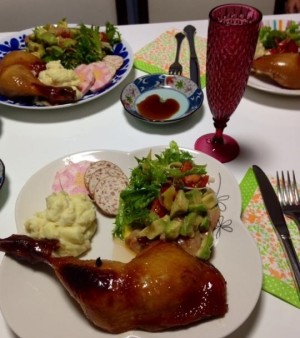
Sushi is often eaten to celebrate special occasions and Christmas is one of many for a lot of locals. From homemade sushi like the ones pictured below, to sushi delivery and yummy but affordable supermarket sushi.
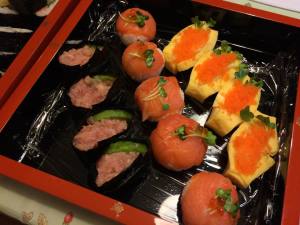
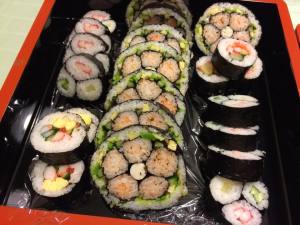
Though people usually work on Christmas eve and on Christmas day in Japan, there are many hosts who would be more than happy to welcome you and share their traditions for dinner so come celebrate with us!
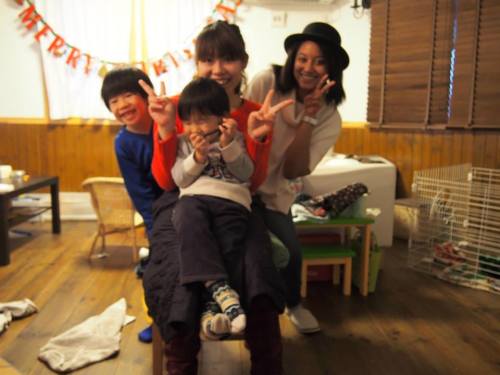
2014-11-10
On November 8th Nagomi Visit had its second annual general assembly and host meet up in Tokyo and the turnout was fantastic.
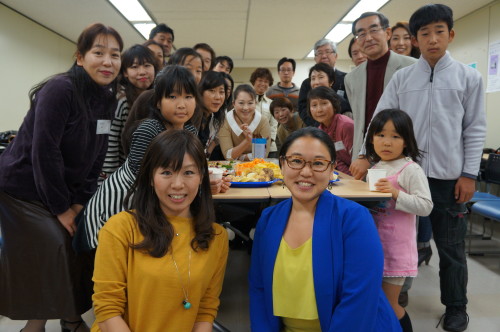
It is hard to put into words how amazing it is to see people of all ages from kids to grandparents come together for the same cause. They were all there to share their passion for cultural exchange and we felt very blessed that everyone in the room understood why the Nagomi Visit Team work so hard day and night to run this program.
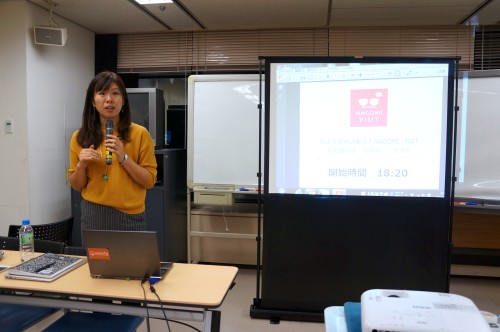
Many of these hosts have welcomed multiple guests and have told us that those experiences have helped them to learn about many things, break stereotypes, and to learn more about their own country.
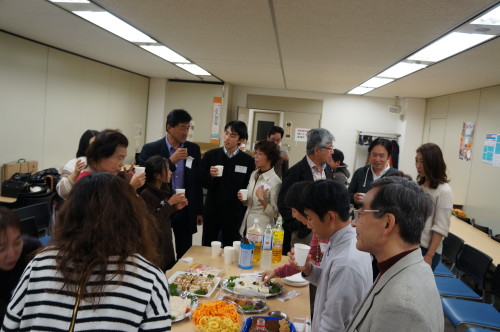
2014-11-01
Nagomi Visit is featured in November’s Swiss International Air Lines inflight magazine as one of “ten reasons to visit Tokyo.”
We are introduced as “a chance to gain an exclusive insight into the daily life of the people of Tokyo.”
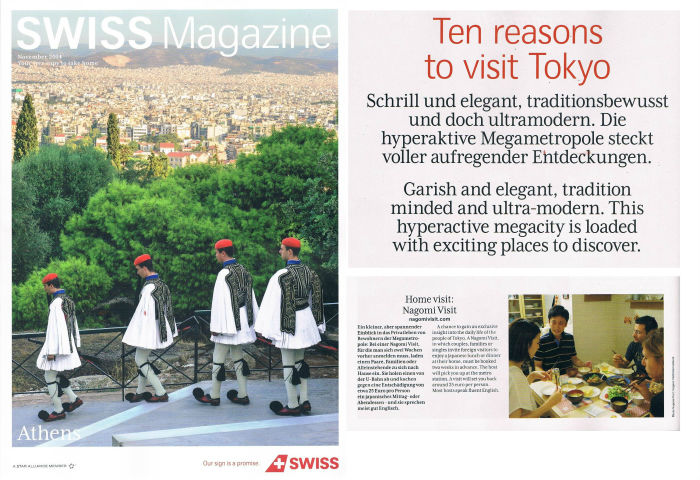
The rest of the article continues describing Nagomi Visit as a recommended activity for those visiting Tokyo "in which couples, families or singles invite foreign visitors to enjoy a Japanese lunch or dinner at their home." Note that just after the article was published we changed it so you only need to book 10 days in advance instead of two weeks to make it easier for more people to participate.
We very much look forward to more people traveling from Zurich and all other parts of Switzerland to join a Nagomi Visit!
2014-10-25
Nagomi Visit at The Minato International Dialogue 2014 "A heart of Omotenashi" and International Cultural Exchange"
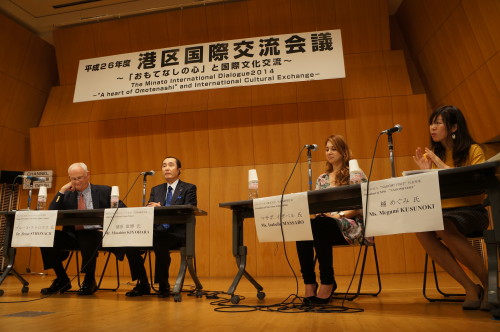
Nagomi Visit’s founder and CEO (right) was a part of a panel last weekend discussing the importance of grassroots international exchange. This was a rewarding way for our organization to share how much we value cultural exchange that goes beyond the surface.
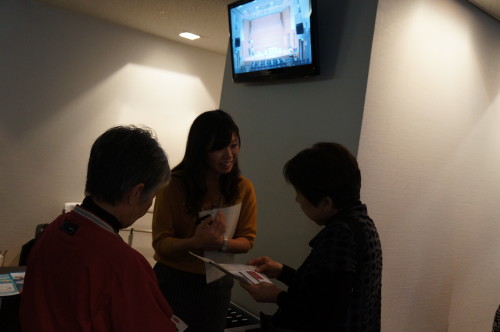
A big arigato to those involved in making this happen! We truly hope more people get to know why we started this organization and continue to run it.
2014-09-28
Being yourself is key at a Nagomi Visit. The host has already read about you through the request you sent, and excited to meet you so there is actually nothing to worry about. Just figure out how to get to your host’s place using Google Maps, or your hosts can definitely help. Make sure to get there on time and be hungry.
However, since this may be your first time going to a Japanese home, you might be a little bit nervous being out of your element so here are a few tips to prepare yourself for your big day.
1. Contact your host before the Nagomi Visit
Email or use your messaging app to contact your host before the Nagomi Visit. Getting to know your host before meeting always makes the Nagomi Visit experience more meaningful for everyone. Check in with them to figure out directions but also, don’t forget to simply share how excited you are to meet them. Communication is key to an enjoyable Nagomi Visit
When preparing an emergency contact
Inform yourself of free wifi services available all across Japan. Buy a sim card for your phone in case there is no wifi available nearby. You can also rent phones or wifi routers at the airport. Make sure you provide the host with an emergency contact number or messaging app account that goes directly to you and not your travel agent.
2. Come hungry
Though the hosts are not put under pressure to cook any more than what they can manage during their busy schedules, many are very eager to go the extra mile so you will be able to get a full experience. So make sure to come hungry not only so you won’t miss out on all the delicious food but as a host, a clean plate is just always nice to see.
3. Be on time
Remember that punctuality is important. Unless a host recommends otherwise, take the train instead of buses or taxis when meeting your host since trains are almost always on time. Keep in mind that trains depart and arrive exactly on the minute their schedules promise, so if your host recommends you get on the train that departs at 17:23 it will most likely depart exactly at that time so make sure to arrive before that so you can get on that train.
4. Say hajimemashite! (hah-gee-may-mah-she-tay) with a smile when you meet your host at the station
It means “nice to meet you” and is a greeting used when you meet someone for the first time. Saying a greeting in Japanese might help to break the ice. Don’t worry if you pronounce the phrase incorrectly, it’s the thought that counts.
5. Refer to the host profile to strike a conversation
The walk from the station to your host’s home is your first opportunity to talk with your host. This might be a good time to refer to the host’s profile to strike a conversation so make sure to read the “Your Nagomi Visit booking is complete!” email you got from us before the Nagomi Visit.
6. Practice the art of taking off your shoes
You may already take off your shoes at the front door in your own home but give the Japanese-way a try. When you enter your host’s home, you may notice that the room’s floor level is higher than the entrance level. The trick is to try your best to place your feet on the floor level right after you take your shoes instead of the entrance level. It might be hard to balance yourself so placing your bags on the floor level before taking off your shoes will help. If your host happens to have slippers prepared, then slip them on. Some travel guides talk about bare feet not being acceptable unless you are a close friend but don’t worry too much about these sorts of details as you are hopefully going to become good friends with your host. What is important is to enter your host’s home with respect and clean feet!
7. Ask if your host needs help
Some hosts might feel it’s rude to have you help as you are their guest, but if you are interested in seeing how they are preparing the food, just ask and most likely your host will be delighted to share.
8. Bring some props to foster conversation
A few digital photos of your hometown, work, hobbies, or local cuisine will make for great conversation. Remember that the host really wants to get to know you so don’t be shy about sharing because that is what a Nagomi Visit is all about.
9. Say itadakimasu before you start eating
Before you start eating, your host will most likely signal you to say in unison, itadakimasu (ee-tah-dah-key-mahss) which means “thank you for the food.”
10. Remember a few rules of etiquette while eating
There is no specific order to eat
Unless you are eating a full course meal at a restaurant, most of the time there is no specific order in which you need to eat your food. Yes sometimes it might be better to try more flavorful or fattier foods last but this has more to do with keeping your taste buds sensitive to the distinct flavors than etiquette. Another example might be when you are making food at the table which happens a lot in Japanese cuisine, like hot pot for instance. The order in which you put the various ingredients has more to do with starting with the ones that take more time to cook. However, the one exception is the shime or finish. Rice or noodles always usually goes in last in the remaining broth so you can fully enjoy the amazing bowl of umami flavor.
Pick up your bowl to eat
If your host has prepared rice and miso soup, remember to try and pick those bowls up with one hand and eat with your chopsticks in the other hand. Sipping is okay when it comes to miso soup but when eating rice, use the chopsticks to bring the rice towards your mouth. Don’t worry too much because the rice will be sticky enough for this to be surprisingly easy. Don’t pick up the other plates or bowls.
Communal plates
A lot of guides say not to take food from the communal plate with your own chopsticks but this actually depends on the host so just ask. You can also tell if they have serving utensils already prepared. If you want to try an advance way, then flip your chopsticks around and try using the top end to pick up the food from the communal plates.
Chopstick etiquette
Yes you may have read somewhere to not pass food from chopstick to chopstick, and to not stick your chopsticks upright in your bowl of rice, but don’t get too stressed out with all the rules. Just Hungry has a great post about the details so if you want to learn more, read through everything before your Nagomi Visit. Just remember, the visit itself is a time of learning too so the host won’t be offended if you make any mistakes. Just do your best.
11.Slip in this one Japanese word while eating
Just remember, oishii (oy-she)! If you think something is delicious, just say it.
12. Say gochiso-sama deshita once everyone has finished eating
When you see that everyone is full and has stopped eating, saying gochiso-sama deshita (goh-chee-soh-sah-mah-day-shee-tah) and for the advanced, adding a oishi katta desu to express how delicious the food was will make your host smile!
13. Gifts are of course great but not a requirement
You probably read somewhere that gift-giving is essential in Japanese culture, and although some of that is true, remember, on a Nagomi Visit, none of our hosts expect you to give them gifts. They are excited to meet you, so your stories and photos are already a gift.
However, if you want to bring a gift, any snacks from your hometown, or you may think of something your host might like after reading their profile.
You may have heard of specific rules of etiquette, such as not bringing any chrysanthemum flowers since they are only for funerals; it is the thought that counts, so don't worry so much about offending your host.
14. Don’t hesitate to ask questions
Your Nagomi Visit is your chance to ask questions. Jot down all your observations or questions if you know you will forget. They may not know the answer but it will always be a good conversation starter and you both might learn something from the experience.
15. Have fun
This one is a no-brainer but wanted to remind you just in case. Yes, etiquette is always good but coming to the Nagomi Visit ready to communicate, listen, and share is probably more important so get ready and have fun!
If you ever have any questions or concerns feel free to contact your host or the Nagomi Visit team anytime!
2014-09-19
Next month on October 25th Nagomi Visit’s founder and CEO will be a panelist speaking about cultural exchange in an event sponsored by Minato City, one of the most international wards in central Tokyo.
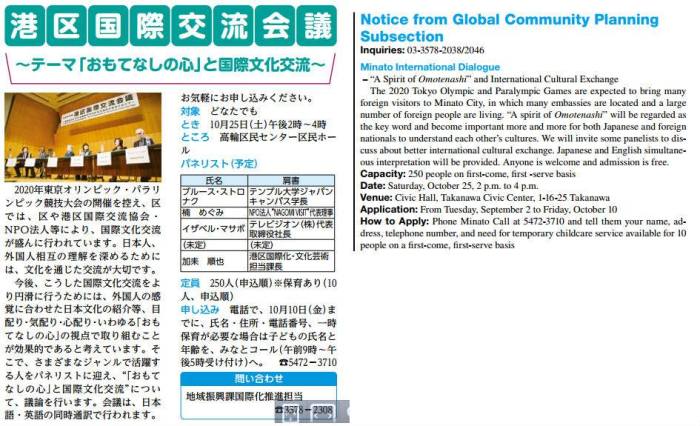
With the 2020 Tokyo Olympics coming up and the Japanese government’s plan to double the number of annual tourist coming to Japan to 20 million, Nagomi Visit is seen as a crucial component in bringing understanding between Japan and the world.
More information in English can be found in the Minato Monthly newsletter. For details in Japanese check out the Minato City website.
 Nagomi Visit
Nagomi Visit























